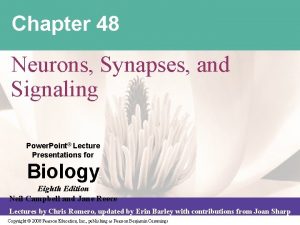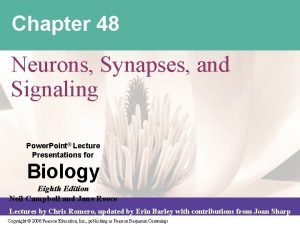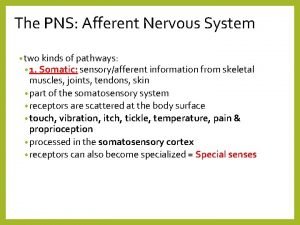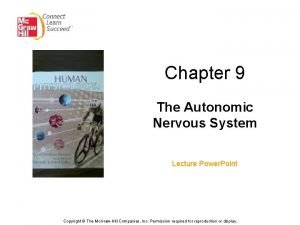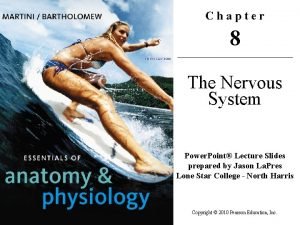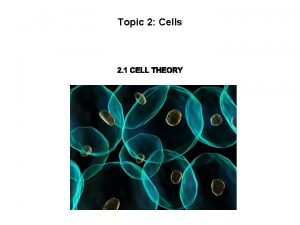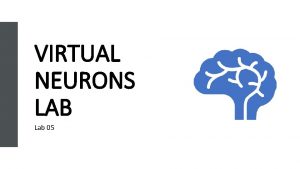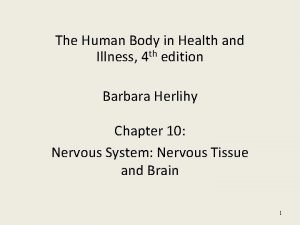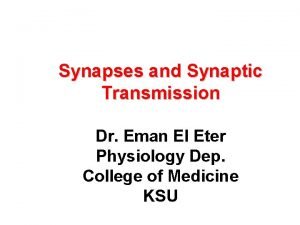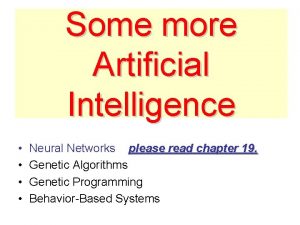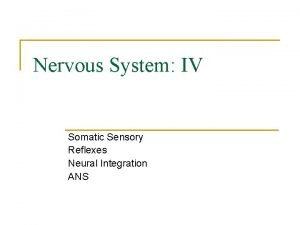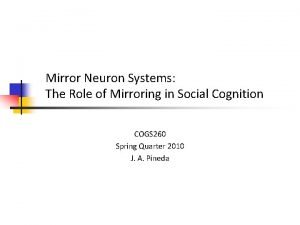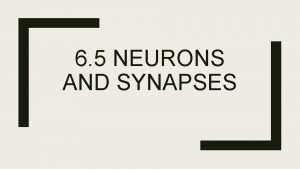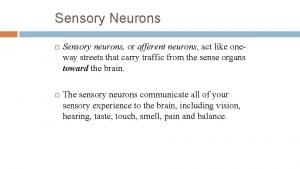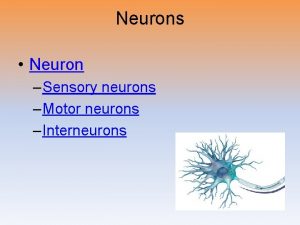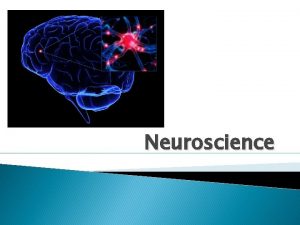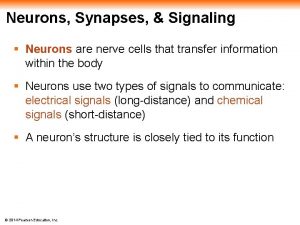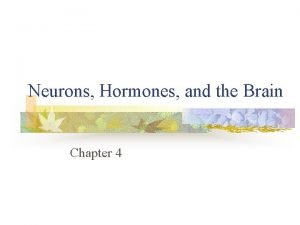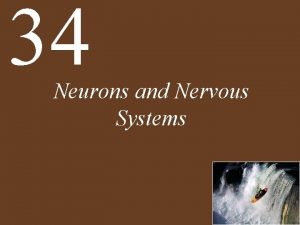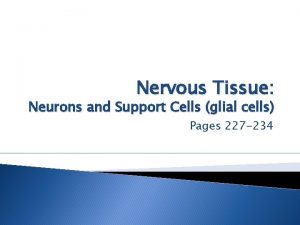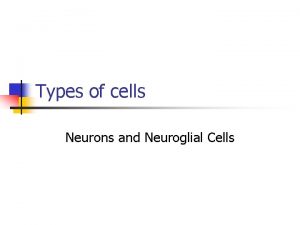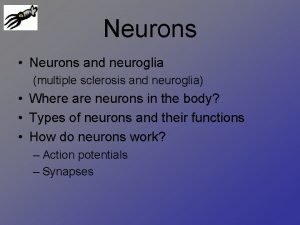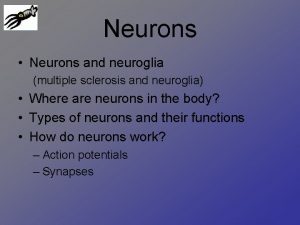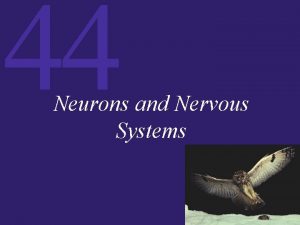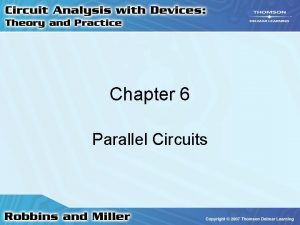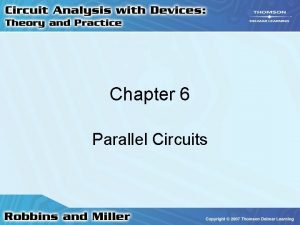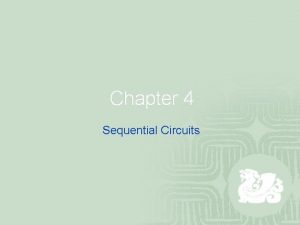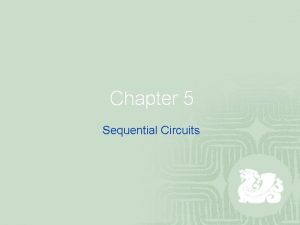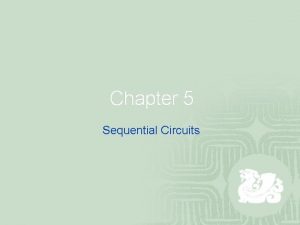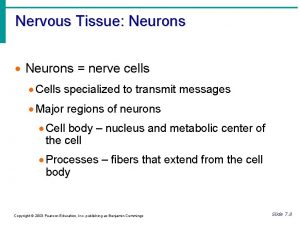Chapter 3 Cells and circuits Outline Neurons Structure


































- Slides: 34


Chapter 3 Cells and circuits

Outline • Neurons: Structure and function • Neurons and glial cells: Collaborations • Lessons from Epilepsy: Neural transmission in review • Mirror neurons, specialized neural circuits, and investigations into ASd

Neurons: Structure and function • • Microstructure Resting membrane potential Action potentials Synaptic transmission

Neurons: Structure and function • Microstructure – Axons – Cell membranes – Dendritic spines

Neurons: Structure and function Early drawings from Cajal

Neurons: Structure and function Cell membrane

Neurons: Structure and function Dendritic Spines

Neurons: Structure and function • How does stress affect neuronal structures? • Bystander Stress vs. actual stress – The mere presence of another animal that had experienced stress

Neurons: Structure and function

Neurons: Structure and function

Neurons: Structure and function • Membrane resting potential – -50 to -80 millivolts

Neurons: Structure and function • Membrane resting potential – -50 to -80 millivolt • How is this balance maintained?

Neurons: Structure and function • Action Potential (nerve impulse) – All or none

Neurons: Structure and function

Neurons: Structure and function

Neurons: Structure and function • Myelin sheath structure

Neurons: Structure and function • How does information transfer between neurons? – Six easy steps

Neurons: Structure and function

Neurons: Structure and function • How do we get depolarized in the first place? – Temporal summation – Spatial summation

Neurons: Structure and function

Neurons & Glial Cells: Collaborations • Astrocytes – Monitor and control levels of ions in the extracellular space – Possess receptors for many neurotransmitters – Facilitate synaptogenesis • Schwann cells – Axonal regrowth in PNS • Oligodendrocytes – Role in major depression

Epilepsy as synchronized excitability • Persist from seconds to minutes. • Partial seizures originate in a localized area • Generalized seizures originate in distributed area

Epilepsy: EEG

General synchronization mechanism • Gap junctions

How to treat epilepsy • Drugs to dampen excitability – Which neurotransmitter(s) should be targeted? • Surgery – Stop activity from spreading – Remove affect region (small or large)

Mirror Neurons • Neurons that respond when engaging in a behavior and when observing that behavior

Mirror Neurons: non-human primates

Mirror Neurons: Humans

Mirror Neurons: associative sequence learning model • Infants see their parents’ faces and imitate the expressions • Co-activation of sensory and motor neurons • Mirror neurons then fire to either sensory or motor

Mirror Neurons: associative sequence learning model

Mirror Neurons • Sensitivity to “intention” (context)

Mirror Neurons • What about developmental disorders that show deficits in “perspective taking” or “theory of mind” ? • Could mirror neurons play a role? • How would you test this hypothesis?

Transcranial magnetic stimulation • Passing electrical current through the coil causes a strong magnetic wave to enter the cortex under the coil, disrupting processing. • How might a researcher use TMS to test the causal relationship between motor areas of the brain involved in speaking and the sensory regions involved in hearing?
 Advantages of parallel circuits over series circuits
Advantages of parallel circuits over series circuits Chapter 8 cellular reproduction cells from cells
Chapter 8 cellular reproduction cells from cells Chapter 48 neurons synapses and signaling
Chapter 48 neurons synapses and signaling Chapter 48 neurons synapses and signaling
Chapter 48 neurons synapses and signaling Onodi cells
Onodi cells Chlorocruorin
Chlorocruorin Plant cell animal cell venn diagram
Plant cell animal cell venn diagram Masses of cells form and steal nutrients from healthy cells
Masses of cells form and steal nutrients from healthy cells Lesson outline lesson 3 describing circuits answers
Lesson outline lesson 3 describing circuits answers Tubular lumen
Tubular lumen Parafollicular
Parafollicular How are somatic cells different from gametes
How are somatic cells different from gametes Somatic cells vs germ cells
Somatic cells vs germ cells Eukaryotic vs prokaryotic cells
Eukaryotic vs prokaryotic cells Prokaryotic vs eukaryotic cells venn diagram
Prokaryotic vs eukaryotic cells venn diagram The organelle trail
The organelle trail Pseudostratified vs simple columnar
Pseudostratified vs simple columnar What cell type
What cell type Are red blood cells prokaryotic or eukaryotic
Are red blood cells prokaryotic or eukaryotic Cells and life lesson 1 answer key
Cells and life lesson 1 answer key Sandwich quote example
Sandwich quote example Neuron order
Neuron order Somatic motor cortex
Somatic motor cortex Clasp knife response
Clasp knife response First second and third order neurons
First second and third order neurons Pre ganglionic
Pre ganglionic Figure 8-2 neurons and neuroglia
Figure 8-2 neurons and neuroglia Outline one therapeutic use of stem cells
Outline one therapeutic use of stem cells Virtual neurons
Virtual neurons Brain homunculus
Brain homunculus 1st order 2nd order 3rd order neurons
1st order 2nd order 3rd order neurons Divergence neurons
Divergence neurons Input neurons
Input neurons Location of sensory neurons
Location of sensory neurons Mirroring 260
Mirroring 260


